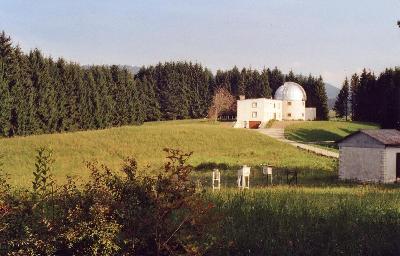Asiago, September 4-18, 2007
The 6th NEON observing school took place at Asiago Observatory (Italy) from Sept. 4th to 18th.
Twenty students of 14 different nationalities performed small research programs
under the guidance of experienced tutors.
These programs covered all aspects of a real observing program,
starting from the preparation of the
observations to the extraction of the scientific results,
including the set-up of the instruments, and the exploration of
the Astronomical Virtual Observatory Databases to see if other interesting
data were available on the corresponding topic.

The group led by E. Giro (Padova), comprising G. Kordopatis (Greece), R. Martinez
(Spain), S. Sodorne (Hungary) and K. Zloczewski (Poland),
studied the polarisation of galaxies in interacting groups.
In face-on, spiral galaxies, the polarisation pattern (i.e. magnetic field pattern) usually follows the
spiral arms, while the situation is more complex in
objects inclined or comprising dust lanes.
Observations of NGC 7625 at the 1.82m telescope showed this galaxy to be a blue compact dwarf, with a strong
dustlane,a rich interstellar medium and numerous starforming regions.
While its nucleus had a polarisation of "only" 0.70 %, the NE part (more disturbed)
has a stronger value of 2.94 +- 0.91, indicating also a stronger magnetic field.
The instrumental polarisation was of course determined and removed, but
indicated that there was much dust on the optics!
The analysis of archival data for ESO 2400-100 showed its polarisation was ranging between 0.11 and 0.30
percent, small values expected for an elliptical galaxy.
On the contrary, RR24, a dusty, interacting pair, showed a maximum polarisation of 3.52 +- 0.32 % in the disturbed region. Remaining questions are how the magnetic field is affected by interactions and what is
the timescale for alignement of particules with the new field, once a disturbance has occured.
The group of L. Sbordone (Paris), with G. de Rosa (Italy), E. Kundra (Slovakia),
S. Nasoudi (Sweden) and G. Petrov (Bulgaria), worked on the chemical analysis of various stars.
High-resolution, VLT/UVES data were reanalysed to master all the problems of echelle spectra.
Synthetic spectra were produced with first guesses of the stellar parameters,
for comparison with the data and determination of abundances of various elements like Fe, Na, Ca, etc...
Direct observations of the same stars at the 1.2m telescope, in low dispersion,
allowed a proper flux calibration to be made, to further constrain the model stars.
After several iterations, the models and observations converged, allowing even the determination of the parameters of the microturbulence.
Small discrepancies remained in the blue part of the spectrum, certainly due to the lower sensitivity of the detector there,
and to the higher atmospheric dispersion during the observations.
The group of J. Dietrich (ESO), with R. D'Abrusco (Italy), K. Jordi (Switzerland), J. Sultana (Malta)
and G. Szasz (Slovakia), searched for galaxies in clusters, using the red-sequence method.
A series of dithered images in Blue and Red were obtained of the cluster Abell 115 with the 1.82m telescope,
in a tile of 3x4, and then mosaiced to produce a composite image.
Some of the peculiar features of that instrument were put into evidence
(gradient in the bias, some charge transfer inefficiency, etc...)
and a proper weight map was produced for the final image.
No clear evidence was found for a red sequence of galaxies, but the scatter
was large in the colour-magnitude diagram.
A composite B,V,R image of the central part of the cluster however revealed that the galaxy
CGCG 480-022 was in fact much bluer than the other objects and was in fact a foreground galaxy.
To complete the program, spectra of some bright galaxies were also obtained with the 1.2m telescope,
allowing this group to have a complete overview of the most important observing techniques.
The group of C. Adami (Marseille), including S. Comeron (Spain), P. Ponente, U. Seemann (Germany) and Y. Wu (China),
investigated "fossile groups" of galaxies, to determine whether they were indeed the results of former mergers
of a large number of galaxies.
For this purpose, a cluster with strong X-ray emission had been selected
and as many as possible redshifts had to be collected, to assess the belonging of individual galaxies to the group
and put the possible existence of a void (search diameter
of up to 500 Mpc) around the center into evidence.
The first task was thus a torough analysis of archival data, in particular the Sloan Digital Sky Survey,
where 888 possible galaxies were found, only 432 of them having a redshift.
After eliminating misidentifications, 83 potential targets remained for further spectroscopy.
This was of course too much for the little observing time available,
but 3 objects could be observed at the 1.2m telescope, and further 2 (fainter ones...) at the 1.82m.
Spectroscopic reductions have no secret anymore for this group, but the work needs to be pursued
in the future to finalise the analysis of this cluster.
Finally, the group of F. Di Mille (Asiago), with N. Bonhomme (France), O. Ozdarcan (Turky), C. Ruhland (Germany)
and K. Stoyanov (Bulgaria), searched for Novae in the neighbourghing galaxy M31.
Imaging in broad band R, and, more important, with a narrow H Alpha filter, was obtained
in several adjacent regions at the 1.82m telescope.
After proper reduction, including astrometry and recentering of the various images,
a mosaic Halpha image was produced, to be compared with
previous images obtained in the same region.
In total, 3 recently discovered Novae were found again,
as well as one pulsating star and one object presumably a
Planetary Nebula (coincidence in position).
One new candidate was discovered, but was unfortunately too faint to obtain immediately a spectroscopic confirmation.
But spectra could be obtained for 2 out of the 3 recent discoveries,
providing the first spectroscopic confirmation of their nature.
Spectra of the bright, galactic Nova Vulpecula (detected this summer) were also obtained,
allowing the students to discover the variety, and the variability, of this class of interesting celestial objects.
Some of these results will be published soon in the appropriate channels for variable objects.